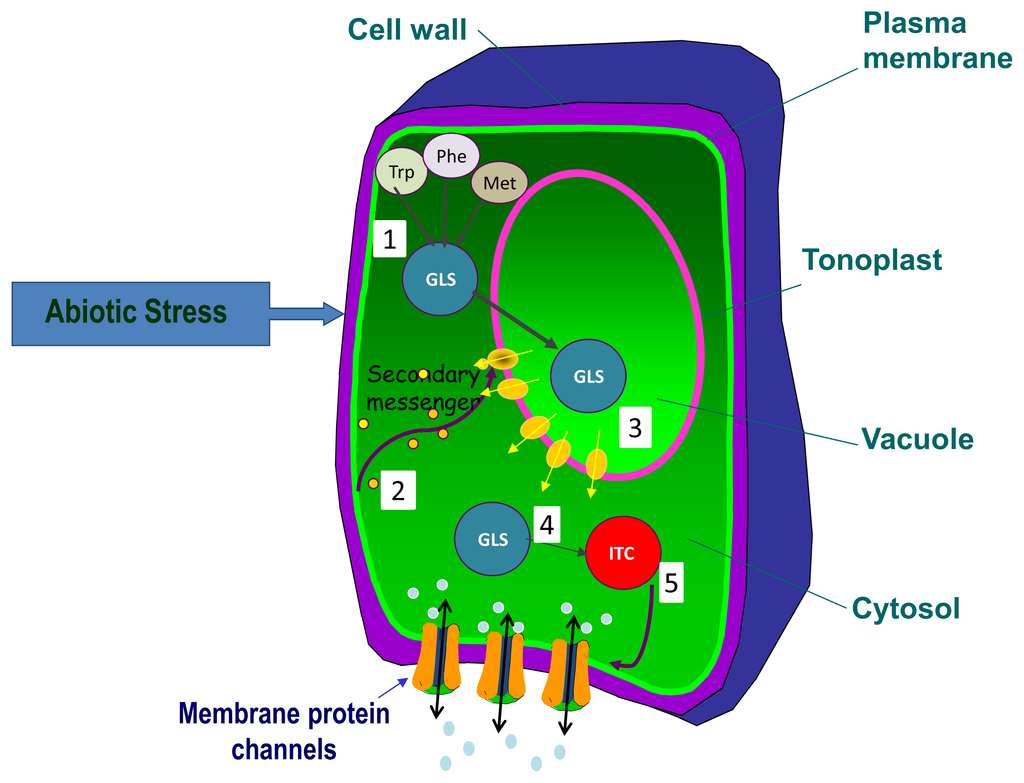del Carmen Martínez-Ballesta, M.; Moreno, D.A.; Carvajal, M. The Physiological Importance of Glucosinolates on Plant Response to Abiotic Stress inBrassica. Int. J. Mol. Sci. 2013, 14, 11607-11625.
Abstract
Glucosinolates, a class of secondary metabolites, mainly found in Brassicaceae, are affected by the changing environment. This review is focusing on the physiological significance of glucosinolates and their hydrolysis products in the plant response to different abiotic stresses. Special attention is paid to the crosstalk between some of the physiological processes involved in stress response and glucosinolate metabolism, with the resulting connection between both pathways in which signaling mechanisms glucosinolate may act as signals themselves. The function of glucosinolates, further than in defense switching, is discussed in terms of alleviating pathogen attack under abiotic stress. The fact that the exogenous addition of glucosinolate hydrolysis products may alleviate certain stress conditions through its effect on specific proteins is described in light of the recent reports, but the molecular mechanisms involved in this response merit further research. Finally, the transient allocation and re-distribution of glucosinolates as a response to environmental changes is summarized.
Concluding Remarks
As conclusive remarks, abiotic stresses, such as salinity, drought, extreme temperatures, light and nutrient deprivation, alter the glucosinolate profiles of plants through different mechanisms (Figure 1), where distinct signaling molecules may be involved. The tight relationship between some physiological processes under abiotic stress and the glucosinolate metabolism suggest that these secondary metabolites may have auxiliary roles associated to these physiological events. This involves a clear connection between the pathways, and glucosinolates may participate on the signaling mechanisms. The fact that glucosinolate follows diurnal variations similar to other plant molecules in response to environmental and external factors may support this idea.

Figure 1. Effect of abiotic stress on glucosinolates (GLS)/allyl-isothiocyanates (ITC) content. (1) The chain-elongation steps of glucosinolates biosynthesis are affected by abiotic stress; (2) Stress perception may lead to increased synthesis of any secondary messenger in the cytosol, facilitating the release of the glucosinolates to the cytoplasm from the vacuole (3). The activity of plant myrosinases will product (allyl-) isothiocyanates (4) that might regulate the transduction or accumulation of other transporters or channels in the plasma membrane (5).
The intensity and duration of the abiotic stress, as well as the developmental stage of the plant at the moment of the imposed stress, are important factors in the accumulation of each specific glucosinolate. This fact conditions the subsequent plant-pathogen interactions, and the plant water availability is decisive in influencing herbivore feeding or the attack by pathogens.
The addition of exogenous glucosinolate hydrolysis products (isothiocyanates) under drought or elevated temperatures alleviated the adverse effects of these unfavorable environments, but the molecular mechanisms involved merit research in order to be clarified. Finally, the fact that a transient allocation and re-distribution of glucosinolates in response to environmental changes is observed could give an indication that glucosinolate-specific function under abiotic stress is still unclear and requires further attention.
See more at
Nenhum comentário:
Postar um comentário